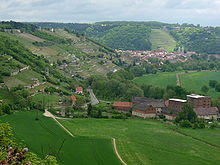Saale-Unstrut (wine-growing region)


The Saale-Unstrut region is a region in central Germany that stretches along the Saale and Unstrut rivers and is home to Germany's northernmost quality wine- growing region. Landscapes with vineyards, steep terraces, centuries-old dry stone walls, vineyard houses and river valleys characterize the 760 hectare Saale-Unstrut wine-growing region, in which viticulture has been practiced for over 1000 years. The wine-growing region is now in the federal states of Saxony-Anhalt (639 ha) and Thuringia (108 ha). Geographically separated from the actual Saale-Unstrut region, the wine-growing area in Werder (Havel) (10 ha) in the state of Brandenburg is also part of the Saale-Unstrut quality wine-growing region , and 3.2 hectares near Westerhausen (Thale) and Quedlinburg north of the Harz Mountains .
The 60 km long Saale-Unstrut Wine Road runs through the wine-growing region . From Memleben it leads along Unstrut and Saale and extends in the north to Weißenfels . Around Höhnstedt near Halle , another wine route invites you to go on an approx. 20 kilometer tour and connects Zappendorf with Unterrissdorf under the name “ Mansfeld Lakes ”. The “White Elster” wine route, which is also 20 kilometers long, leads from Wetterzeube to Posa Monastery in Zeitz .
Typical of the region, the Saale-Unstrut wines are characterized by a delicate and fruity bouquet with mineral nuances. Shell limestone weathered soils , but also red sandstone , loess loam and copper slate can be found. In the river valleys, "heat islands" ensure a particularly mild microclimate . The sun shines about 1600 hours a year. With around 500 mm of precipitation annually, the wine-growing region is one of the driest in Germany. The average yield is around 50 hl / ha.
There are over 50 different grape varieties on Saale-Unstrut, most of which are grown dry. At the top of the white wine list are Müller-Thurgau , Pinot Blanc and Pinot Gris as well as Bacchus , Riesling , Silvaner , Gutedel and Kerner . Approx. 24% of the wines grown are red wines such as Dornfelder , Portuguese , Pinot Noir and the Blaue Zweigelt .
The land around Saale and Unstrut is famous for its castles, palaces and churches. The southern route of the Romanesque Road leads through the region. Tourist marketing is carried out by Saale-Unstrut-Tourismus e. V.
The Naumburg Cathedral is one of the most important late Romanesque buildings in Saxony-Anhalt, is a station on the Romanesque Road and has been a UNESCO World Heritage Site since 2018.
History of viticulture
Viticulture in the Saale-Unstrut region has a 1000-year tradition. As early as 998, a deed of gift from Emperor Otto III. the viticulture mentioned. Some time before that, with the expansion of Christianity, viticulture was already practiced in large parts of Thuringia. In 786, for example, viticulture is documented in Dorndorf an der Werra (West Thuringia). At Saale-Unstrut, it was primarily the monks of the Cistercian monastery of Sancta Maria Schulpforta , founded in 1137, who further developed viticulture. At that time, wine was not only a privilege, but also a basic food for the population, because surface water was mostly inedible and well water was scarce and unsustainable. In the 16th century, viticulture flourished with a cultivation area of 10,000 hectares. The Thirty Years' War and the deterioration in the climate in the late 17th and early 18th centuries brought about a considerable setback , as in the entire agriculture of Central Europe . In addition, coffee, tea and cocoa appeared as competitors and good quality and cheaper wines were imported from other regions. In 1835 the Naumburger Weinbaugesellschaft was founded, which endeavored to improve cultivation methods and breed new grapes.
The phylloxera brought in 1887 the wine almost to a standstill and the Saale-Unstrut was declared the first phylloxera you area in Germany. When the Biological Reichsanstalt was founded in Naumburg in 1919 , the area under cultivation was only 100 hectares. In the context of the search for a remedy against phylloxera, Carl Börner showed that American vines are resistant to phylloxera and forced the breeding of documents . From 1923 onwards, the cultivation of grafted vines was approved in Germany and the fight against phylloxera was won.
After 1945, viticulture in the Saale-Unstrut region could only survive through hobby winemakers, until viticulture was finally subsidized by the state in the 1960s and the vineyards expanded again. After the fall of the Wall there was an upswing that continues to this day, so that the total planted area is around 760 hectares today.
The Saale-Unstrut area wine queen has been elected annually since 1969 .
